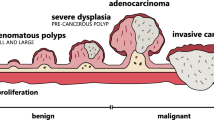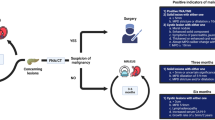Abstract
Background
Adenoma detection rate (ADR) is an important quality indicator of colonoscopy. High-definition (HD) colonoscopy has been reported to increase ADR compared to standard-definition (SD) colonoscopy. Although there are few reports comparing the latest generation and the previous generation of HD colonoscopy equipment, there are reports that the latest generation colonoscopy equipment improves ADR. However, there are no reports on the impact of the latest generation HD colonoscopy on the ADR of trainee endoscopists.
Aims
The aim of this study was to investigate whether the latest generation HD colonoscopy increases the ADR of trainee endoscopists compared with the previous generation HD colonoscopy.
Method
We conducted a retrospective review of medical records of patients aged 40–79 years old, who underwent screening or surveillance colonoscopy performed by nine gastroenterology fellows at Dong-A University Hospital from March 2019 to February 2020. We calculated the overall ratios of the ADR: the ADRs of the group using the older generation HD colonoscopy equipment and the group using the latest HD colonoscopy equipment. Polyp detection rate (PDR), sessile serrated polyp detection rate (SSPDR), and advanced neoplasia detection rate (ANDR) were calculated for each group. Factors related to adenoma detection were identified using logistic regression analysis.
Results
Altogether, 2189 patients were included in the study (the older HD colonoscopy group comprising 1183 and the latest HD colonoscopy group comprising 1006). We found that PDR (45.98 vs. 51.69%, p = 0.008) and ADR (35.67 vs. 40.85%, p = 0.013) were significantly higher in the latest generation HD colonoscopy group. The generational differences were not statistically significant for SSPDR (1.94 vs. 2.78%, p = 0.195) or ANDR (4.65 vs. 4.97%, p = 0.726). In the multivariate regression analysis, age, male sex, the latest generation HD colonoscopy, and long withdrawal time were the most significant factors affecting adenoma detection.
Conclusions
The latest generation HD colonoscopy improved PDR and ADR by trainee endoscopists. These findings suggest that latest generation, higher-resolution colonoscopy equipment can improve the quality of colonoscopy for less experienced endoscopists.
Similar content being viewed by others
References
Bray F, Ferlay J, Soerjomataram I, Siegel RL, Torre LA, Jemal A. Global cancer statistics 2018: GLOBOCAN estimates of incidence and mortality worldwide for 36 cancers in 185 countries. CA Cancer J Clin.. 2018;68:394–424. https://doi.org/10.3322/caac.21492.
Schoenfeld P, Cash B, Flood A, et al. Colonoscopic screening of average-risk women for colorectal neoplasia. N Engl J Med. 2005;352:2061–2068. https://doi.org/10.1056/NEJMoa042990.
Levin B, Lieberman DA, McFarland B, et al. Screening and surveillance for the early detection of colorectal cancer and adenomatous polyps, 2008: a joint guideline from the American Cancer Society, the US Multi-Society Task Force on Colorectal Cancer, and the American College of Radiology. Gastroenterology. 2008;134:1570–1595. https://doi.org/10.1053/j.gastro.2008.02.002.
Jacob BJ, Moineddin R, Sutradhar R, Baxter NN, Urbach DR. Effect of colonoscopy on colorectal cancer incidence and mortality: an instrumental variable analysis. Gastrointest Endosc. 2012;76:355.e1–364.e1. https://doi.org/10.1016/j.gie.2012.03.247.
Zauber AG, Winawer SJ, O’Brien MJ, et al. Colonoscopic polypectomy and long-term prevention of colorectal-cancer deaths. N Engl J Med. 2012;366:687–696. https://doi.org/10.1056/NEJMoa1100370.
Citarda F, Tomaselli G, Capocaccia R, Barcherini S, Crespi M. Efficacy in standard clinical practice of colonoscopic polypectomy in reducing colorectal cancer incidence. Gut. 2001;48:812–815. https://doi.org/10.1136/gut.48.6.812.
Winawer SJ, Zauber AG, Ho MN, et al. Prevention of colorectal cancer by colonoscopic polypectomy: The National Polyp Study Workgroup. N Engl J Med. 1993;329:1977–1981. https://doi.org/10.1056/nejm199312303292701.
Doubeni CA, Corley DA, Quinn VP, et al. Effectiveness of screening colonoscopy in reducing the risk of death from right and left colon cancer: a large community-based study. Gut. 2018;67:291–298. https://doi.org/10.1136/gutjnl-2016-312712.
Rabeneck L, Paszat LF, Saskin R, Stukel TA. Association between colonoscopy rates and colorectal cancer mortality. Am J Gastroenterol. 2010;105:1627–1632. https://doi.org/10.1038/ajg.2010.83.
Adler J, Robertson DJ. Interval colorectal cancer after colonoscopy: exploring explanations and solutions. Am J Gastroenterol. 2015;110:1657–1664. https://doi.org/10.1038/ajg.2015.365.
Corley DA, Jensen CD, Marks AR, et al. Adenoma detection rate and risk of colorectal cancer and death. N Engl J Med. 2014;370:1298–1306. https://doi.org/10.1056/NEJMoa1309086.
Kaminski MF, Regula J, Kraszewska E, et al. Quality indicators for colonoscopy and the risk of interval cancer. N Engl J Med. 2010;362:1795–1803. https://doi.org/10.1056/NEJMoa0907667.
Rutter MD, Beintaris I, Valori R, et al. World endoscopy organization consensus statements on post-colonoscopy and post-imaging colorectal cancer. Gastroenterology. 2018;155:909.e3–925.e3. https://doi.org/10.1053/j.gastro.2018.05.038.
Kaminski MF, Wieszczy P, Rupinski M, et al. Increased rate of adenoma detection associates with reduced risk of colorectal cancer and death. Gastroenterology. 2017;153:98–105. https://doi.org/10.1053/j.gastro.2017.04.006.
Zorzi M, Senore C, Da Re F, et al. Detection rate and predictive factors of sessile serrated polyps in an organised colorectal cancer screening programme with immunochemical faecal occult blood test: the EQuIPE study (evaluating quality indicators of the performance of endoscopy). Gut. 2017;66:1233–1240. https://doi.org/10.1136/gutjnl-2015-310587.
Leufkens AM, DeMarco DC, Rastogi A, et al. Effect of a retrograde-viewing device on adenoma detection rate during colonoscopy: the TERRACE study. Gastrointest Endosc. 2011;73:480–489. https://doi.org/10.1016/j.gie.2010.09.004.
Gralnek IM, Siersema PD, Halpern Z, et al. Standard forward-viewing colonoscopy versus full-spectrum endoscopy: an international, multicentre, randomised, tandem colonoscopy trial. Lancet Oncol. 2014;15:353–360. https://doi.org/10.1016/s1470-2045(14)70020-8.
Dik VK, Gralnek IM, Segol O, et al. Multicenter, randomized, tandem evaluation of EndoRings colonoscopy–results of the CLEVER study. Endoscopy. 2015;47:1151–1158. https://doi.org/10.1055/s-0034-1392421.
Wang P, Berzin TM, Glissen Brown JR, et al. Real-time automatic detection system increases colonoscopic polyp and adenoma detection rates: a prospective randomised controlled study. Gut. 2019;68:1813–1819. https://doi.org/10.1136/gutjnl-2018-317500.
DeWitt J, Van Dam J. Development of endoscopy- gastroenterology diamond jubilee review. Gastroenterology. 2018;155:237–240. https://doi.org/10.1053/j.gastro.2018.04.002.
Yasser MBKAD, Chauhan SS, Gottlieb KT, et al. High-definition and high-magnification endoscopes. Gastrointest Endosc. 2014;80:919–927. https://doi.org/10.1016/j.gie.2014.06.019.
Longcroft-Wheaton G, Brown J, Cowlishaw D, Higgins B, Bhandari P. High-definition vs standard-definition colonoscopy in the characterization of small colonic polyps: results from a randomized trial. Endoscopy. 2012;44:905–910. https://doi.org/10.1055/s-0032-1310004.
Roelandt P, Demedts I, Willekens H, et al. Impact of endoscopy system, high definition, and virtual chromoendoscopy in daily routine colonoscopy: a randomized trial. Endoscopy. 2019;51:237–243. https://doi.org/10.1055/a-0755-7471.
Zimmermann-Fraedrich K, Groth S, Sehner S, et al. Effects of two instrument-generation changes on adenoma detection rate during screening colonoscopy: results from a prospective randomized comparative study. Endoscopy. 2018;50:878–885. https://doi.org/10.1055/a-0607-2636.
Bond A, O’Toole P, Fisher G, et al. New-generation high-definition colonoscopes increase adenoma detection when screening a moderate-risk population for colorectal cancer. Clin Colorectal Cancer. 2017;16:44–50. https://doi.org/10.1016/j.clcc.2016.07.006.
Park SK, Park SH, Yang HJ, et al. Simple proxies for detection of clinically significant serrated polyps and data for their benchmarks. J Gastroenterol Hepatol. 2020;. https://doi.org/10.1111/jgh.14977.
Adler A, Aminalai A, Aschenbeck J, et al. Latest generation, wide-angle, high-definition colonoscopes increase adenoma detection rate. Clin Gastroenterol Hepatol. 2012;10:155–159. https://doi.org/10.1016/j.cgh.2011.10.026.
Jrebi NY, Hefty M, Jalouta T, et al. High-definition colonoscopy increases adenoma detection rate. Surg Endosc. 2017;31:78–84. https://doi.org/10.1007/s00464-016-4986-7.
Pioche M, Denis A, Allescher HD, et al. Impact of 2 generational improvements in colonoscopes on adenoma miss rates: results of a prospective randomized multicenter tandem study. Gastrointest Endosc. 2018;88:107–116. https://doi.org/10.1016/j.gie.2018.01.025.
Hassan C, Pickhardt PJ, Kim DH, et al. Systematic review: distribution of advanced neoplasia according to polyp size at screening colonoscopy. Aliment Pharmacol Ther. 2010;31:210–217. https://doi.org/10.1111/j.1365-2036.2009.04160.x.
Paggi S, Radaelli F, Repici A, Hassan C. Advances in the removal of diminutive colorectal polyps. Expert Rev Gastroenterol Hepatol. 2015;9(2):237–244. https://doi.org/10.1586/17474124.2014.950955.
van Rijn JC, Reitsma JB, Stoker J, Bossuyt PM, van Deventer SJ, Dekker E. Polyp miss rate determined by tandem colonoscopy: a systematic review. Am J Gastroenterol. 2006;101:343–350. https://doi.org/10.1111/j.1572-0241.2006.00390.x.
Heresbach D, Barrioz T, Lapalus MG, et al. Miss rate for colorectal neoplastic polyps: a prospective multicenter study of back-to-back video colonoscopies. Endoscopy. 2008;40:284–290. https://doi.org/10.1055/s-2007-995618.
Zhao S, Wang S, Pan P, et al. Magnitude, risk factors, and factors associated with adenoma miss rate of tandem colonoscopy: a systematic review and meta-analysis. Gastroenterology. 2019;156:1661.e3–1674.e11. https://doi.org/10.1053/j.gastro.2019.01.260.
Kudo S, Hirota S, Nakajima T, et al. Colorectal tumours and pit pattern. J Clin Pathol. 1994;47:880–885. https://doi.org/10.1136/jcp.47.10.880.
Hurlstone DP, Cross SS, Adam I, et al. Endoscopic morphological anticipation of submucosal invasion in flat and depressed colorectal lesions: clinical implications and subtype analysis of the kudo type V pit pattern using high-magnification-chromoscopic colonoscopy. Colorectal Dis. 2004;6:369–375. https://doi.org/10.1111/j.1463-1318.2004.00667.x.
Tobaru T, Mitsuyama K, Tsuruta O, Kawano H, Sata M. Sub-classification of type VI pit patterns in colorectal tumors: relation to the depth of tumor invasion. Int J Oncol. 2008;33:503–508.
Li M, Ali SM, Umm-a-OmarahGilani S, Liu J, Li YQ, Zuo XL. Kudo’s pit pattern classification for colorectal neoplasms: a meta-analysis. World J Gastroenterol. 2014;20:12649–12656. https://doi.org/10.3748/wjg.v20.i35.12649.
Iacucci M, Kiesslich R, Gui X, et al. Beyond white light: optical enhancement in conjunction with magnification colonoscopy for the assessment of mucosal healing in ulcerative colitis. Endoscopy. 2017;49:553–559. https://doi.org/10.1055/s-0042-124363.
Klenske E, Zopf S, Neufert C, et al. I-scan optical enhancement for the in vivo prediction of diminutive colorectal polyp histology: results from a prospective three-phased multicentre trial. PLoS ONE. 2018;13:e0197520. https://doi.org/10.1371/journal.pone.0197520.
Iacucci M, Trovato C, Daperno M, et al. Development and validation of the SIMPLE endoscopic classification of diminutive and small colorectal polyps. Endoscopy. 2018;50:779–789. https://doi.org/10.1055/s-0044-100791.
Funding
This study was funded by Dong-A University.
Author information
Authors and Affiliations
Corresponding author
Ethics declarations
Ethics statement
Approval of our research protocols by the ethics committee was in accordance with international agreements (World Medical Association Declaration of Helsinki: ethical principles for medical research involving human subjects). For this type of study formal consent is not required. The present study protocol was reviewed and approved by the Institutional Review Board of Dong-A University College of Medicine (DAUHIRB-20-051).
Conflict of interest
The authors declare that they have no conflict of interest.
Additional information
Publisher's Note
Springer Nature remains neutral with regard to jurisdictional claims in published maps and institutional affiliations.
Electronic supplementary material
Below is the link to the electronic supplementary material.
Rights and permissions
About this article
Cite this article
Lee, J.Y., Koh, M. & Lee, J.H. Latest Generation High-Definition Colonoscopy Increases Adenoma Detection Rate by Trainee Endoscopists. Dig Dis Sci 66, 2756–2762 (2021). https://doi.org/10.1007/s10620-020-06543-5
Received:
Accepted:
Published:
Issue Date:
DOI: https://doi.org/10.1007/s10620-020-06543-5




